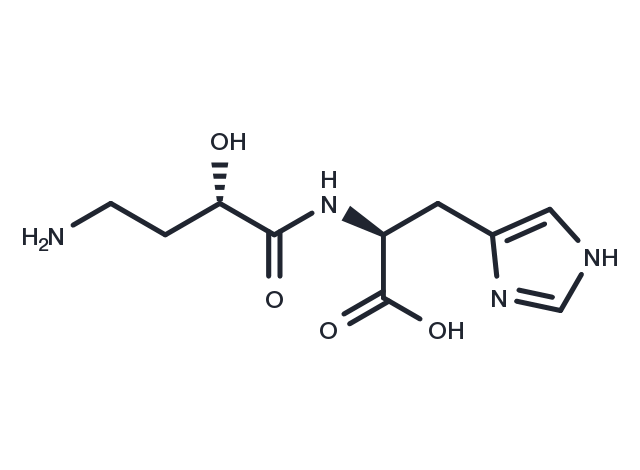keep away from moisture
Powder: -20°C for 3 years | In solvent: -80°C for 1 year

Carnostatine (SAN9812) is a potent and selective carnosinase 1 ( CN1 ) inhibitor with a K i of 11 nM for human recombinant CN1. Carnostatine may be used to increase renal carnosine concentration as a potential therapeutic modality for diabetic nephropathy (DN). [1].

| Pack Size | Availability | Price/USD | Quantity |
|---|---|---|---|
| 25 mg | 10-14 weeks | $ 1,520.00 | |
| 50 mg | 10-14 weeks | $ 1,980.00 | |
| 100 mg | 10-14 weeks | $ 2,500.00 |
| Description | Carnostatine (SAN9812) is a potent and selective carnosinase 1 ( CN1 ) inhibitor with a K i of 11 nM for human recombinant CN1. Carnostatine may be used to increase renal carnosine concentration as a potential therapeutic modality for diabetic nephropathy (DN). [1]. |
| Targets&IC50 | CN1 (human):ki: 11 nM |
| In vitro | Carnostatine inhibits CN1 activity in human serum and serum of transgenic mice-overexpressing human CN1. At a carnosine concentration of 200 μM, Carnostatine has an IC 50 value of 18 nM on human recombinant CN1, i.e., close to the K m of 190 μM [1]. |
| In vivo | Subcutaneous injection of 30 mg/kg Carnostatine (SAN9812) consistently lowers CN1 activity in the bloodstream of human CN1 transgenic (TG) mice. When Carnostatine is administered alongside Carnosine, there is up to a 100-fold increase in Carnosine concentrations in both plasma and kidneys compared to CN1-overexpressing mice that have not received any treatment. The animal model used for this study involves human carnosinase (CNDP1) transgenic mice set against a BTBR wt/ob genetic background. The dosage tested includes 3 mg/kg intravenously (i.v.) or 30 mg/kg subcutaneously (s.c.), focusing on pharmacokinetic analysis. The results indicate that a single subcutaneous dose of 30 mg/kg effectively suppresses circulating CN1 activity. |
| Synonyms | SAN9812 |
| Molecular Weight | 256.26 |
| Formula | C10H16N4O4 |
| CAS No. | T10684 |
keep away from moisture
Powder: -20°C for 3 years | In solvent: -80°C for 1 year
You can also refer to dose conversion for different animals. More
bottom
Please see Inhibitor Handling Instructions for more frequently ask questions. Topics include: how to prepare stock solutions, how to store products, and cautions on cell-based assays & animal experiments, etc.
Carnostatine T10684 Others SAN9812 SAN-9812 SAN 9812 inhibitor inhibit
